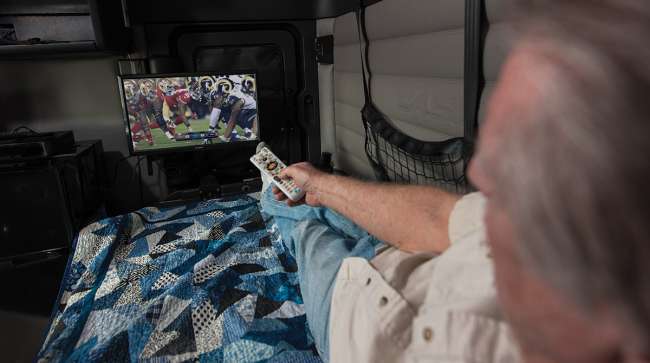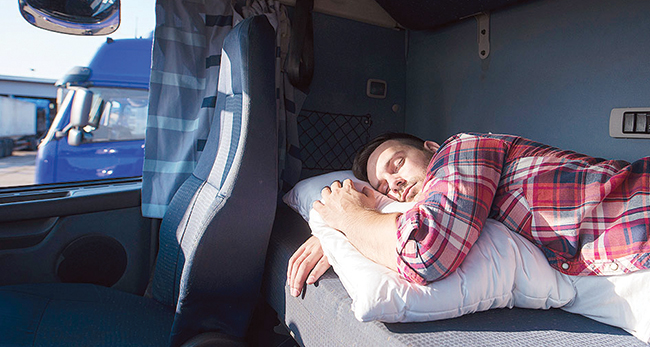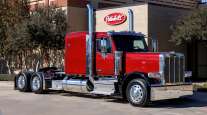Senior Reporter
New 7/3 Split Sleeper Berth Rule Appears Slow to Gain Popularity

[Stay on top of transportation news: Get TTNews in your inbox.]
Veteran owner-operator truck driver Gary Buchs says that splitting sleeper berth time might have some advantages, but frankly he finds it pretty darn confusing.
“I use the 8/2 split a lot,” Buchs said at a 2018 Federal Motor Carrier Safety Administration listening session in Dallas. “It can be difficult — the math can be difficult.”
He uses a computer program to help him figure out how the sleeper berth split impacts his 14-hour workday.
“As an officer once told me, you have to be an Einstein to do your logbook,” Buchs said. “Many of us that are in this business know that.”
Fast-forward two years later — the more things change and the more they seem to stay the same: A tweak of the hours-of-service (HOS) rule that went into effect on Sept. 29 has put a new 7/3 split in the mix as an alternative to meet 10-hour off-duty requirements in the sleeper berth. It also may be a bit confusing.
Which could explain — at least in part — why regulators and tech experts are hearing that the new 7/3 split appears to be slow in taking hold in the trucking industry. Even on the internet boards, where truckers jaw about their issues of the day, questions on the 7/3 split are common.
Essentially for a 7/3 split, a driver has to stay in the sleeper berth for seven hours, and then spend another three hours relaxing somehow, or even going back into the berth.
Dan Horvath, vice president of safety policy for American Trucking Associations, said that anecdotally he’s hearing that the 7/3 split hasn’t yet been picked up by a large segment of the industry. Currently, about 48% of drivers on U.S. highways have a sleeper berth in their truck, according to FMCSA research. A sleeper berth can help cut down on overnight lodging expenses.

Horvath
“I think one problem that kind of complicates it is that, with the pandemic, carriers may have held off on changing schedules around to allow that additional split until a time that it fits their operation,” Horvath said. “Split sleeper berth has always been a little confusing to carriers and drivers because of how you have to calculate your in-times, how much time you have left to drive.”
Electronic logging device provider EROAD last year conducted a preliminary analysis comparing the impact of the HOS changes one month after the rule tweak went into effect on Sept. 29, said Soona Lee, EROAD’s director of regulatory compliance for North America.
“We noticed with drivers using EROAD there was an increase in the number of them using the split SB rule after the HOS changes took effect,” Lee told Transport Topics.
But the survey also showed that drivers and companies have fundamentally not yet shifted their schedules to benefit fully from the 7/3 splits, Lee said.

Wirachowsky
“The 7/3 split has been a difficult thing for the industry to understand — and they don’t want to get it wrong,” said Kerri Wirachowsky, director of the roadside inspection program for the Commercial Vehicle Safety Alliance. “So until they really understand how to use it, and how to use it appropriately, they hesitate to use it.”
Wirachowsky noted that the new HOS rule has cut down the number of hours violations significantly. But when it comes to sleeper berth, violations are difficult to estimate.
“To be honest with you, I’m not using 2020 data for anything because the emergency declaration has been on for the entire year,” she said. “So it doesn’t really give you an indication that there are violations, because in some cases, drivers are driving over their hours and they’re allowed to.”
Wirachowsky also noted that in those cases, violations are not being cited or recorded.
More Modifications
Now there could soon be another addition to the sleeper berth split.
On Jan. 14, FMCSA issued a news release that indicated the agency plans to seek a pilot project to collect data to determine if a 6/4 and 5/5 split would be safe and effective. Some in the industry have been clamoring for such a decision for years.
“FMCSA continues to explore ways to provide flexibility for drivers while maintaining safety on our roadways,” then-Deputy Administrator Wiley Deck said in a statement. “This proposed pilot program will provide needed data and feedback for the agency to use now and in the future. Gathering more data on split sleeper flexibility will benefit all commercial motor vehicle stakeholders. We encourage everyone to review this proposal and provide their public comment.”
FMCSA said that during the proposed pilot program, participating drivers would have the option to split their 10 hours of sleeper berth time into two periods, provided that the two periods provide a combined rest amount of at least 10 hours in length. When operating under the pilot program exemption, drivers would be expected to split their sleeper berth time into two periods such that neither period is less than four hours in length; however, drivers would be free to choose whether or not to operate under the exemption based on their schedule. Carriers and drivers desiring to participate would apply to FMCSA for acceptance in the proposed pilot program.
RELATED: Industry Responds to FMCSA’s Proposed Sleeper Berth Pilot Program
Neither the 5/5 nor 6/4 split period would count against the driver’s 14-hour driving window, FMCSA said.
The agency has been toying with an effort to add the two new splits since 2014.
The proposal has not been published in the Federal Register, which means it will be subject to a review by the new Biden administration, according to a Jan. 20 White House memo.
“Quite frankly, we were a bit surprised that it was announced,” said ATA’s Horvath. “It’s not one on my shortlist radar.”
“ATA, along with the Minnesota Trucking Association, petitioned FMCSA for a split sleeper pilot program several years ago. We had members stating that they’d like more flexibility with split sleeper berth. The data’s not there to support. We want the data to support it,” he said.
The ATA petition died after the agency said it lacked the data to entertain a new rule, plus some sleep research has indicated that drivers need at least seven hours of sleep to be fresh.
“It’s a little bit disheartening that maybe we could have been a little further into the data-collection process, had we started this a few years back,” Horvath said. “Hopefully we can get a pilot program off the ground in the future. Our view is let’s get the data out and let’s go the route the data takes us.”

A driver sleeps in the sleeper berth. (Smederevac/Getty Images)
But would a 5/5 or 6/4 split actually be safe, and how might it help drivers?
Horvath said the more flexible split could potentially allow a driver to avoid rush hour traffic situations. “Perhaps taking a break earlier in the day without worrying about it penalizing their 14-hour clock, which is constantly running,” Horvath said. “That certainly could be a safety benefit.”
“If you look at the data on FMCSA’s website, there’s no question that the 11-and 14-hour rule violations have decreased,” Wirachowsky said. “But I’m not going to suggest to you though that it’s because of the 7/3 split.
“As far as the positives, the new split does give drivers more flexibility when they are held up. Now they can use the shorter time in the berth and now they can actually stop their clock if they turn around and take a sleeper berth.”

Home | Video | Heroes' Photo Gallery
Saluting the men and women of the trucking industry who kept America's essential goods flowing during the coronavirus pandemic.
Heroes: Peter Lacoste | Susan Dawson | James Rogers | Reggie Barrows | Kevin Cooper | Cesar Quintana Moreno
The 7/3 split is also one step closer to Canada’s splits that already allow 5/5, 6/4, 7/3 and 8/2 splits, giving drivers who work in both countries more flexibility, Wirachowsky said.
After years of observation and inspections, Wirachowsky said that some sleeper berths she has seen are really nice but others are not so nice.
“It really comes down to some owner-operators who live in them. Some of them are beautiful, they have everything in them. They’ve got microwaves, fridges and TVs, and that’s their home. That’s where they live.
“Then you have others that are basically slip-seat drivers, it’s not their truck, and they don’t care.”
Want more news? Listen to today's daily briefing below or go here for more info:


